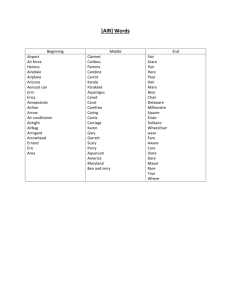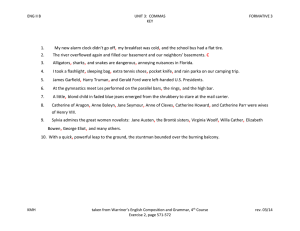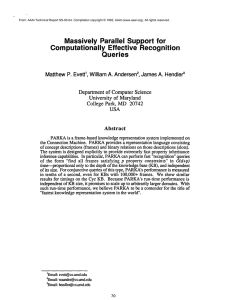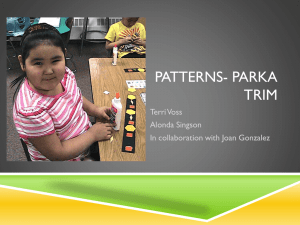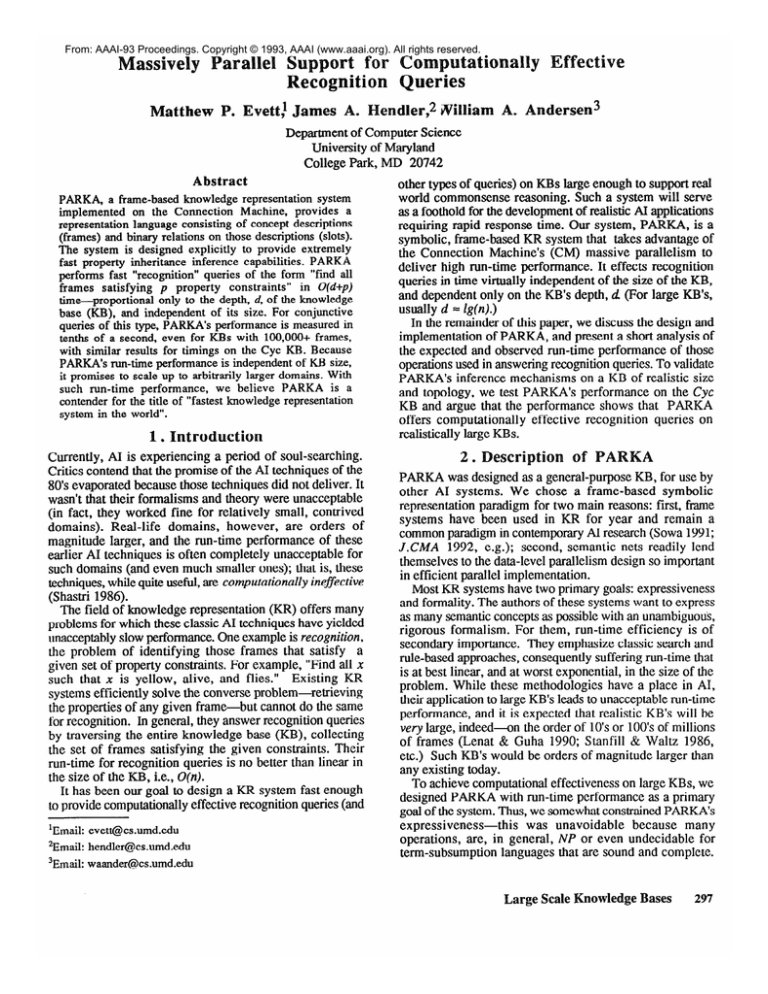
From: AAAI-93 Proceedings. Copyright © 1993, AAAI (www.aaai.org). All rights reserved.
Department of Computer Science
University of Maryland
College Park, MD 20742
Abstract
PARKA, a frame-based knowledge representation system
implemented on the Connection Machine, provides a
representation language consisting of concept descriptions
(frames) and binary relations on those descriptions (slots).
The system is designed explicitly to provide extremely
fast property inheritance inference capabilities. PARKA
performs fast “recognition” queries of the form “find all
frames satisfying p property constraints” in O(d+p)
time-proportional only to the depth, (i, of the knowledge
base (KB), and independent of its size. For conjunctive
queries of this type, PARKA’s performance is measured in
tenths of a second, even for KBs with 100,000+ frames,
with similar results for timings on the Cyc KB. Because
PARKA’s run-time performance is independent of KB size,
it promises to scale up to arbitrarily larger domains. With
such run-time performance, we believe PARKA is a
contender for the title of “fastest knowledge representation
system in the world”.
I.
Introduction
Currently, AI is experiencing a period of soul-searching.
Critics contend that the promise of the AI techniques of the
80’s evaporated because those techniques did not deliver. It
wasn’t that their formalisms and theory were unacceptable
(in fact, they worked fine for relatively small, contrived
domains). Real-life domains, however, are orders of
magnitude larger, and the run-time performance of these
earlier AI techniques is often completely unacceptable for
such domains (and even much smaller ones); that is, these
techniques, while quite useful, are computationaZZyhefictive
(Shastri 1986).
The field of knowledge representation (KR) offers many
problems for which these classic AI techniques have yielded
unacceptably slow performance. One example is recognition,
the problem of identifying those frames that satisfy a
given set of property constraints. For example, “Find all x
such that x is yellow, alive, and flies.” Existing KR
systems efficiently solve the converse problem-retrieving
the properties of any given frame-but cannot do the same
for recognition. In general, they answer recognition queries
by traversing the entire knowledge base (KB), collecting
the set of frames satisfying the given constraints. Their
run-time for recognition queries is no better than linear in
the size of the KB, i.e., O(n).
It has been our goal to design a KR system fast enough
to provide computationally effective recognition queries (and
‘Email: evett@cs.umd.edu
2Email: hendler@cs.umd.edu
3Email: waander@cs.umd.edu
other types of queries) on KBs large enough to support real
world commonsense reasoning. Such a system will serve
as a foothold for the development of realistic AI applications
requiring rapid response time. Our system, PARKA, is a
symbolic, frame-based KR system that takes advantage of
the Connection Machine’s (CM) massive parallelism to
deliver high run-time performance. It effects recognition
queries in time virtually independent of the size of the KB,
and dependent only on the KB’s depth, d (For large KB’s,
usually d = /g(n).)
In the remainder of this paper, we discuss the design and
implementation of PARKA, and present a short analysis of
the expected and observed run-time performance of those
operations used in answering recognition queries. To validate
PARKA’s inference mechanisms on a KB of realistic size
and topology, we test PARKA’s performance on the Cyc
KB and argue that the performance shows that PARKA
offers computationally effective recognition queries on
realistically large KBs.
2.
PARKA was designed
a general-purpose KB, for use by
other AI systems. We chose a frame-based symbolic
representation paradigm for two main reasons: first, fmme
systems have been used in KR for year and remain a
common paradigm in contemporary AI research (Sowa 1991;
J.CMA 1992, e.g.); second, semantic nets readily lend
themselves to the data-level parallelism design so important
in efficient parallel implementation.
Most KR systems have two primary goals: expressiveness
and formality. The authors of these systems want to express
as many semantic concepts as possible with an unambiguous,
rigorous formalism. For them, run-time efficiency is of
secondary importance. They emphasize classic search and
rule-based approaches, consequently suffering run-time that
is at best linear, and at worst exponential, in the size of the
problem. While these methodologies have a place in AI,
their application to large KB’s leads to unacceptable run-time
performance, and it is expected that realistic KB’s will be
very large, indeed-on the order of lo’s or 100’s of millions
of frames (Lenat & Guha 1990; Stanfill & Waltz 1986,
etc.) Such KB’s would be orders of magnitude larger than
any existing today.
To achieve computational effectiveness on large KBs, we
designed PARKA with run-time performance as a primary
goal of the system. Thus, we somewhat constrained PARKA’s
expressiveness-this
was unavoidable because many
operations, are, in general, NP or even undecidable for
term-subsumption languages that are sound and complete.
Large Scale Knowledge
297
Recognition, in particular, is NP, though it is a special
case of classification, which can be undecidable (Rebel
1990). So, although PARKA’s semantics are roughly based
upon those of NETL (Fahlman 1979) and KL-0NlE (Bra&man
& Schmolze 1985), we avoided semantic constructs lacking
a computationally effective implementation. We believe
PARKA’s run-time performance on even very large KBs
more than compensates
for its slighlty restricted
expressiveness when compared to that of other, serial, KR
systems.
2. I Design specifics
PARKA is a basic frame system: each fkame corresponds to
a concept represented in the KB and the collection of relations
to which it belongs. Relations among concepts are represented
as directed graphs whose arcs (or links) are stored as frame
pointers in the slots of frames. Properties of frames are
represented as relations for which the domain is the frames
having the property, and the range is the corresponding
property values. The KB can be viewed as the network
formed by the frames and the links that connect them,
similar to a semantic network (Fahlman 1979, e.g.)
Ontological relations among frames are encoded via the
IS-A (“is a”) relation, which is intimately involved in the
calculation of property inheritance inferences (see below)
As such, it has special status in PARKA. The subgraph
consisting of all IS-A links and frames is referred to as the
IS-A hierarchy of the net. All PARKA IS-A hierarchies are
rooted and acyclic.
A small subset of a frame network is shown in Figure 1.
The frames are shown as ovals. The properties of each
frame are represented by the arcs emanating from them.
Unlabelled arcs are IS-A links.
such node. In that case, PARKA disambiguates among
viable ancestors.
The first version of PARKA (Evett, Spector & Hendler
1993; Evett & Hendler 1992) handled multipleinheritance-as have other frame-based KR systems (i.e.,
Brachman & Schmolze 1985, e.g.)-by using inheritance
path length to disambiguate multiple inheritance paths.
The system chooses the ancestor having the shortest IS-A
path from the inheritor. This inheritance paradigm suffers
from redundancy, ambiguity, and other problems, and has
been soundly criticized in the philosophical community as
being epistemologically inadequate. Many of these criticisms
are detailed in (Touretzky 1986) and (Brachman 1985).
The current implementation uses a top-down, path-based,
credulous inheritance mechanism based on Touretzky’s IDQ
metric to disambiguate multiple inherited values that works
like this: assume the frame in question, X, is not explicitly
valued for the given property, P. Let B be the set of
ancestors (B,, B,, ...) of X that are explicitly valued for P.
X takes B,‘s value for P as its own, provided B,. is an
element of B such that there is no B. 0’f i) such that B. is
an IS-A descendant of Bi. If more than one element of B
meets this criterion, X is said to be ambiguously valued for
Property p.
Unfortunately, many retrieval operations involving topdown, path-based inheritance mechanisms, including IDO,
have been shown to be m-hard (Selman & Levesque 1989).
To calculate these operations in a timely manner, we adopted
a slightly weaker ordering scheme for inheritance
disambiguation. Again, let B be the set of ancestors of X
that are explicitly valued for property P. X takes Bi’s value
for P as its own, where Bi is that element of B with the
largest topoZogica2 number. The topological number,
topo(Z), of a frame Z,
is defined inductively:
topo(rootNode)=O and for all other
frames, Z,
topo(Z) = I+ max(topo(y)) where C is the set of frames
YEC
Figure I: Subset of a Frame Network
2.2 Inheritance
PARKA employs a property inheritance mechanism on its
IS-A hierarchy. A frame is said to be explicitly-valued for a
given property if it is incident on a property link of that
type-that is, if the frame contains a slot by that name.
Any frame not explicitly-valued for a given property inherits
the value of its nearest ancestor(s) (using a metric based on
Touretzky’s inferential distance ordering (IDO)) that is
explicitly-valued for that property. Because PARKA supports
multiple inheritance, it is possible to have more than one
298
Evett
that are parents of Z.
Though PARKA’s disambiguation mechanism is not quite
as powerful as complete IDO, it enjoys many of the same
advantages and is considerably stronger than a simple pathlength based scheme. It does not suffer from the problems
of redundancy noted in (Touretzky 1986) and in only one
case does our inheritance scheme differ from IDO: in full
IDO, if there are two explicitly valued ancestors, X and Y,
but X is also an ancestor of Y, then Y is “more specific”
than X, and so its property value is chosen. Our topological
disambiguation
scheme, however, may arbitrarily
disambiguate among the two ancestors, even when neither
is an IS-A ancestor of the other. In the vast majority of
cases, though, PARKA’s mechanism is equivalent to IDO.
PARKA’s encoding of the Cyc commonsensc KB (see Section
3.4) revealed no cases in which PARKA disambiguates an
inheritance relation that is ambiguous via IDO. If Cyc
turns out to be typical of future KBs, this shortcoming of
topologicial disambiguation will have little impact on most
inferences.
3. I Inheritance
2.3 Implementation
PARKA’s internal representation of a frame consists of a
block of processors, one for each of that frame’s IS-A
parents. These processors are contiguous across the CM’s
processor address space. One processor of each block is
distinguished as a referent for all other frames pointing to
the represented frame.
The slots of each frame are encoded in a slot table, stored
in one of the processors of that frame’s block. The table is
a list of pairs (<property>, <property-value>),
each
component being a processor address. Figure 2 illustrates
the internal representation on the CM of part of the net
shown in Figure 1. The large rectangles represent the
distinguished processor of each block of processors
corresponding to a particular frame. The smaller rectangles
represent the remaining processors of those blocks. The
square-bracketed values represent the address of the processor
representing the property of that corresponding name.
processor #20
processor #21
processor #140
name:
IS-A:
slot-table:
1
1
processor segment for frame
“Barney”
Figure 2: Internal CM representation of a small
subset of a frame network
To determine if a frame, Y, is explicitly valued for a
given property, P, PARKA determines the (explicit) value
of P for every frame in the KB by scanning through every
frame’s slot table in parallel, seeking an entry corresponding
to P. If a matching entry is found in frame Y’s slot table,
the corresponding value stored there is the address of the
processor representing the frame that is the value of property
P for frame Y. In general, slot retrieval is proportional to
the size of the largest slot table in the KB. Because property
values tend to be scattered across inheritance paths, these
tables are typically quite small. The largest slot table in
our implementation of the Cyc KB had only 43 entries.
Even so, PARKA maintains a cache of the most recently
accessed properties to accelerate explicit property look-up.
3.
Almost all KB queries involve some inferencing along the
IS-A hierarchy because almost all involve calculating the
inherited value of a set of properties for a set of frames.
PARKA uses several data structures to make such inheritance
inferencing very fast, including using multiple processors
to represent frames having multiple parents. PARKA uses
an activation wave propagation algorithm to calculate the
value for a given property of every frame in the KB in time
independent of the size of the network.
First, the IS-A root frame is “activated”, forming a nascent
activation wave. At each iteration, this wave is passed
downward along IS-A links. The activation wave propagates
synchronously; all nodes in the current “wave front”
simultaneously activating the incident nodes that have not
yet been activated. Each such iteration is a propagation
step. Because PARKA is implemented on the CM, each
propagation step is accomplished with a single parallel
operation. In detail, at propagation step i:
esformance
To demonstrate that PARKA provides computationally
effective KR, we implemented and timed several retrieval
operations on very large KBs which included inheritance
queries on very large, pseudo-random KB’s and recognition
queries on the Cyc KB.
1. Frames with a topological value of i (i.e., those at
topological level i) that are explicitly valued for the
property set their wave value to k, where k’s high
order bits are i, and k’s low order bits are the frame’s
property value.
2. Every frame (processor) not explicitly valued for the
property in question that has parent nodes at topological
level i-l “pulls” down the value of the activation wave
from those parents.
3 Non-explicitly valued frames at topological level i
choose as their own activation wave value the largest
of those pulled down from the parent frames. Because
the high order bits of each wave value arc the topological
level of the origin node, the selected value conforms to
the inheritance scheme outlined in section 2.2.
Figure 3: The Basic Inheritance Algorithm
The number of propagation steps required to calculate a
property value is equivalent to the depth, d, of the network’s
IS-A hierarchy. Consequently, PARKA’s run-time for queries
such as “what things are black?“, is O(d), and is independent
of the size of the KB. We refer to such queries as “top-down”,
and they are the bane of most serial KR systems, requiring
O(n) time to effect, where n is the size of the KB. Serial
systems use indexing schemes to mitigate this computational
morass, but indexing can be unsatisfactory for a variety of
reasons (as we discuss in (Kettler, Hendler & Andersen
1993b)) including that it is typically infeasible to explicitly
index all properties.
The comparison between serial and parallel run-times is
more striking when realizing that for realistic networks d =
Zg(n). It is commonly believed that such network shallowness
will persist and probably be accentuated as net size increases.
Our PARKA implementation of the Cyc commonsense MB
(see section 3.4), enjoys a similarly shallow IS-A topology.
To compare PARKA against a serial representation system,
we created a serial version of PARKA, called SPARKA
Large Scale
owledge Bases
299
(“serial-PARKA”). To make the comparison as fair as
possible, we implemented SPARKA as a severely strippeddown version of a more complete serial implementation
(detailed in (Spector, Evett & Hendler 1990)). It has very
little functionality other than for simple property inheritance
calculations, but is optimized to effect those calculations as
quickly as possible.
We tested our analytical predictions of PARKA’s run-time
performance of simple property inheritance queries by timing
PARKA’s response to example queries on topologies of
varying size and depth. Then, we timed SPARKA on the
same queries and networks. The networks were quite large-up
to 128K nodes4. Because encoding such large networks by
hand was not possible, we developed algorithms for generating
pseudo-random
networks with certain topological
characteristics. These techniques are described in (Evett,
Spector & Hendler 1993; Evett & Hendler 1992). Our
experience with the Cyc KB (see section 3.4) has affirmed
our belief that the topologies used to measure PARKA’s
performance reflect those of realistic KBs.
Cl
1 parent, serial
A
1 parent, PARKA
0
4 parents, serial
0
4 parents, PARKA
1.8
1.6
.a 0.8
El
$ 0.6 d---d-
04
“Ejgmgm
\D
2
3
Knowledge Base Size (proc&ors)
Figure 4: Run-time performance of inheritance queries
on 8-level networks of varying sizes.
Figure 4 shows PARKA’s run-time for frame networks
of depth 8, and of varying size. This timing suite isolates
the effect of network size on run-time. These timings
support our supposition that PARKA’s computation of
inheritance queries is independent of network size’. Thus,
%mings were made on a “quarter” CM-2, consisting of only
16K processors.
‘Actually, we observed a correlation between PARKA’s runtime and the size of the networks. We examined this degradation
away from our theoretical performance predictions (the results
of this study are detailed in (Evett & Hendler 1993)). The
degradation is completely accounted for by the performance of
300
Evett
PARKA’s
performance should scale up to arbitrarily larger
KBs. The serial system’s run-time, on the other hand, was
linear with respect to network size. The figure contains
best-fit curves to highlight this linear relation.
The networks used in the timings were of two topological
types: trees (each frame with exactly one parent) and directed
graphs (each frame with between one and four parents). We
used different topologies to demonstrate that PARKA’s runtime is independent of upward IS-A fan-out.
A comparison between the performance figures of
SPARKA and PARKA in Figure 4 demonstrates that the
latter remains computationally effective even for very large
KBs, while the former’s performance is unacceptable for
large networks. We anticipate that this contrast will become
increasingly stark for much larger KBs of applications in
real-world domains.
3 2 Recognition
Queries
The ability to solve recognition queries has driven much of
PARKA’s design. The problem of recognition is well-known
in the field of KR (Wilensky 1986, e.g.) and is the problem
of answering KB queries of the form: “find all frames x
such that P,(x,c,) A P2(x,c,) A . . . A P (x,cJ, where Pi(x,ci),
Vi, is a unary predicate true for alf frames, X, that have
value ci for property Pi. E.g.: “What object is most
characterized by this list of property values? ....” and “what
have trunks, tusks, and are big and gray?” Such queries are
extremely time-consuming for serial-based systems, often
running in time no better than O(pn), even on systems
employing a highly constrained description language.
PARKA’s ability to execute inheritance inferences quickly
makes it particularly suitable to recognition. Because
PARKA determines which objects have a given value for a
given property in O(d) time, PARKA determines which
objects satisfy a set of p property constraints in no more
than 0(&J time, where d is the depth of the net.
But PARKA does even better, using a pipelining technique
to evaluate recognition queries in time O(d+p). Because
each wave propagation step of an inheritance inference occurs
“in lockstep” -all frames at the same topological level
calculating their property value simultaneously-pipelining
can be added to the basic process outlined in Figure 3. At
each propagation step i, all frames at topological level j,
such that p2j>i , retrieve from their parent(s) the wave
activation value having to do with the (j-i)-th element of
the set of properties being inferred. Thus, the complete
propagation requires a+-1 propagation steps.
3.3 Using Cyc for Validation of PARKA
We tested our run-time predictions by timing PARKA’s
performance for recognition queries on an implementation
of the Cyc KB (Lenat & Guha 1990). Our motivation for
using Cyc to evaluate PARKA’s performance is twofold.
First, we want to validate PARKA’s inference mechanisms
on a KB of large size and realistic topology. Because Cyc
the CM’s interprocessor communication operations. The runtime of these operations degrades proportionally with router
network load.
is the largest and most comprehensive commonsense KB in
existence, it is an obvious choice. A second and more
exciting motivation is that we envision some future version
of Cyc being built on top of a massively parallel substrate,
like PARKA, to make its reasoning services fast enough to
be used by an intelligent agent operating in the world in
real time.
On the lowest level, Cyc consists of a frame system
(frames are called “units” in Cyc), representing assertions
(in the form of binary relations, or slots) about entities in
the world. Above that level is the CycL “constraint language”,
which allows the specification of inferences to be made
about units in the KB. The inference mechanisms provided
by CycL range from the very simple, such as the slot
(e.g.
father(John,Mary)
+
mechanism
inverse
fatherOf(Mary,John)), to theorem proving using general
“wffs”, and to unsound inference methods such as analogy.
PARKA implements only some of the inference
capabilities provided by CycL, particularly those having to
do with property inheritance. For our tests we represented
only that subset of Cyc that involved IS-A based property
inheritance and ontologies. This subset contained a total of
26,214 units, 8591 (33%) of which were collections, and
17,623 (67%) instances. Of the instances, 403 1 (15% of
the total) were slots (slots are explicitly represented in the
Cyc ontology). To accommodate a KB of this size, we used
a 16,384 processor CM-2 with a virtual processor ratio of
4:l. The maximum depth of the KB along the IS-A relation
was 23, (i.e., shallow relative to KB size, as expected.)
3.4 Performance
of
ecognition
Queries
To test recognition query performance, we timed queries
similar to those usedby CycL to find units “similar” to a
given unit. Units are considered similar if they share the
same values for a number of properties exceeding some
threshold. First, we selected a Cyc unit (#%Bumta-1986)
with a relatively large number (22) of local assertions (i.e.,
explicitly-valued properties), assigning an arbitrary ordering
to those properties. We then ran recognition queries in
PARKA to identify those frames that matched at least 50%
of the first n slots (II n 122) of #%Burma-1986. The
recognition queries themselves, then, involved between 1
and 22 conjuncts. The run-time performance of these queries
is plotted in Figure 5.
As Figure 5 clearly shows, the time required to perform
recognition queries grows only linearly in the number of
conjuncts, p, and overall performance, even for a query of
22 conjuncts, is excellent. The run-time matches the Q(d+p)
performance predicted by analysis. This performance
compares very favorably with recognition queries on serial
systems, which require O(pn) time for the same queries,
where n is the size of the MB. Recognition queries in
PARKA are independent of KB size, and should scale up to
arbitrarily larger domains. Indeed, in (Kettler et al 1993a)
we report sub-second run-time performance of recognition
queries in a case-based planning system using KB’s of over
100,000 frames. This is a speed-up of more than 10,000
over the highly optimized serial version of PARKA.
O.OUOO
0
5
20
10
15
Number of Conjuncts
25
Figure 5: Run-time of recognition queries of various
sizes on the PARKA implementation of the Cyc KB
This experiment was designed not ony to demonstrate the
O(d+p) complexity of conjunctive recognition queries in
PARKA, but also to show that PARKA can supply fast
matching for analogy-related
functions, a task that
traditionally has been difficult for serial systems. For
example, the CycL query that most nearly corresponds to
those of Figure 5 finds only an arbitrary subset of the
matching units. By exhaustively matching the probe against
the entire KB simultaneously, PARKA finds all appropriate
matches.
elate
ark
PARKA is intended as a basis for large AI systems. The
implementation of the Cyc KB in PARKA is the first of a
series of uses of PARKA in other large AI systems. Potential
uses for PARKA include case-based AI systems, as the
basis of a massively parallel knowledge server, and as part
of a knowledge-mining system. We plan to examine how
PARKA might be more fully integrated into the Cyc
representation system, proper.
Also, we implemented a simple version of PARKA on
the MIMD CM-5. Preliminary results show that we should
be able to represent KBs of over 1M fi-ameson a lK-processor
CM-5 and obtain run-time performance nearly an order of
magnitude better than the results in this paper. Because the
C&I-5 is a MIMD machine (though we use it as a SPMD
machine), we can use several inferencing techniques that
aren’t possible on the SIMD CM-2. In particular, we plan
to use an active messaging scheme (Von Eicken et al 1992)
to increase the flexibility of PARKA’s memory association
schemes, and to increase the use of pipelining in inferencing.
There are a few other parallel KR systems (Geller 1991;
Moldovan, Lee & Lin 1989 to name two) and these are
discussed more fully in (Evett 1993).
Large Scale Knowledge Bases
301
5.
Conclusion
Using Real World Knowledge. MIT Press, Cambridge,
Using KBs with over 100,000 frames, we have shown that
PARKA computes property inheritance and recognition
queries in time independent of the size of the KB and
dependent only on network depth. The run-time of these
operations is in the tenths of seconds. This performance
compares very favorably to serial representation systems.
Because empirical evidence to date supports our analytical
claims, we believe that PARKA’s performance will scale
up to larger KBs, even to the those necessitated by memory
based reasoning6 technology. Thus, we argue that PARKA
can supply computationally effective recognition queries
for realistic KBs.
Acknowledgments
The author wishes to thank the Systems Research Center at
the University of Maryland, for their early support in this
research, and for the continuing use of their hardware in the
development of PARKA. The authors also wish to thank
the University of Maryland Institute for Academic Computing
Services (UMIACS) and Thinking Machines Corp. for the
use of their Connection Machines. The support staff at
both institutions was very helpful during the development
of PARKA.
This work has been supported by AFOSR grant 01-528180, ONR grant NOO14-88-K-0560, and NSF grant lRl8907890.
eferences
Brachman, R.J. I Lied about the Trees. AI Msg. 6, 3 (Fall,
1985).
Brachman, R.J. and Schmolze, J.G. An Overview of the
KL-ONE Knowledge Representation System. Cog. Sci.,
9,2 (April-June 1985).
J. Computers and Mathematics with Applications -
special
issue on semantic networks, 2 3(2-5), 1992.
Evett, M.P. PARKA: A System for Massively Parallel
Knowledge Representation.
Ph.D. diss., Dept. of
Computer Science, Univ. Maryland, College Park, 1993.
Forthcoming.
Evett, M.P., Spector, L. and Hendler, J.A. Massively Parallel
Frame-Based Property Inheritance in PARKA. To appear
in Journal for Parallel and Distributed Computing.
Evett, M.P. and Hendler, J.A. Degradation of Interprocessor
Communication Operations on the Connection Machine.
Tech. Rep., Department of Computer Science, Univ.
Maryland, College Park, March, 1993.
Evett, M.P. and Hendler, J.A. An Update of PARKA, a
Massively Parallel Knowledge Representation System.
Tech. Rep., CS-TR-2850, Department of Computer
Science, Univ. Maryland, College Park, February, 1992.
Fahlman, S.E. NETL: A System for Representing and
%Ve use the term “MBR” in a broader sense than in (Stanfill
& Waltz 1986) to include such paradigms as case-based reasoning
(Hammond 1989; Kettler et al 1993; Kitano & Higuchi 1991.)
302
Evett
MA, 1979.
Operations in Massively Parallel
n. Tech. Rep. CIS-91-28, Dept.
Computer and Information Science, New Jersey Institute
of Technology, Newark, NJ, 199 1.
Hammond, K. Case-Based Planning: Viewing Planning as
a Memory Task. Academic Press, 1989.
Kettler, B .P., Hendler,
J.A., Andersen, W.A., and
Evett, M.P. (1993a) “Massively Parallel Support for a
Case-based Planning System”. In Proceedings of the
Ninth IEEE Conference on AI Applications, IEEE 1993.
Kettler, B.P., Hendler, J.A. and Andersen, W.A. (1993b)
Why Explicit Indexing Can’t Work.
Tech. Rep.,
Department of Computer Science, Univ. Maryland,
College Park, April, 1993.
Kitano, H. and Higuchi, T. Massively Parallel Memory-Based
Parsing. Proceedings of IJCAI-91, 199 1.
Lenat, D.B. and Guha, R.V. Building Large Knowledge-Based
Systems. Addison Wesley, Reading, Mass., 1990.
Moldovan, D., Lee, W., and Lin, C. SNAP: A MarkerPropagation Architecture for Knowledge Processing. Tech.
Rep. CENG 89-10, Dept. Electrical Engineering-Systems,
Univ. of Southern California, Los Angeles, CA, 1989.
Nebel, B. Terminological Reasoning Is Inherently Intractable.
AIJ, 43,2 (May, 1990).
Selman, B. and Levesque, H. The Tractability of Path-Based
Inheritance. Proceedings of IJCAI-89, Morgan-Kaufman,
San Mateo, CA, 1989.
Shastri, L. Massive Parallelism in Artificial Intelligence.
Tech. Rep. MS-CIS-86-77 (LINC LAB 43), Dept. of
Computer and Information Science, University of
Pennsylvania, Philadelphia, PA, 1986.
Sowa, J. (ed.) Principles of Semantic Networks. MorganKaufman, San Mateo, CA, 1991.
Spector, L., Evett, M. and Hendler, J.. Knowledge
Representation
in PARKA. Tech. Rep. TR-2409,
Department of Computer Science, University of Maryland,
College Park, MD, Feb. 1990.
Stanfill, C. and Waltz, D. Toward Memory-Based Reasoning.
Communications of the ACM, Vol. 29, No. 12, December
1986, pp. 1213-1228.
Touretzky, D.S. The Mathematics of Inheritance Systems.
Morgan Kaufmann, Los Altos, CA, 1986.
Von Eicken, T., Culler, D., Goldstein, S. and Schauser, K.
Active Messages: a Mechanism
for Integrated
Communication and Computation. Tech. Rep. UCB/CSD
92/#675, Computer Science Division, EECS, University
of California, Berkeley, CA, 1992.
Wilensky, R. Some Problems and Proposals for Knowledge
Representation. Tech. Rep. UCB/CSD 86/294, University
of California, Berkeley, May 1986.

